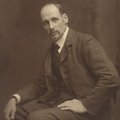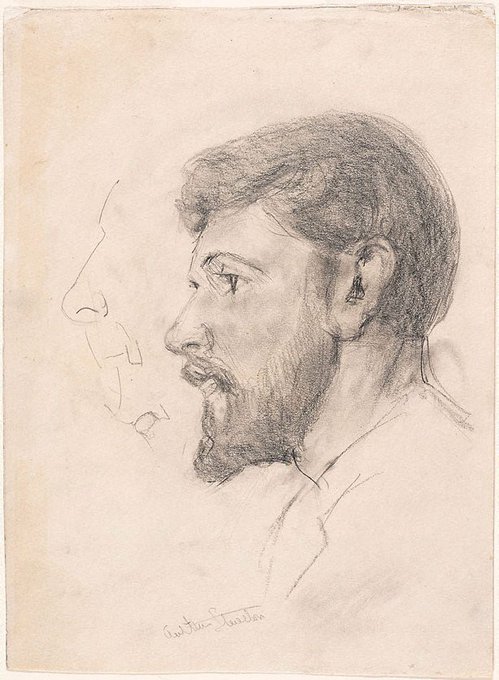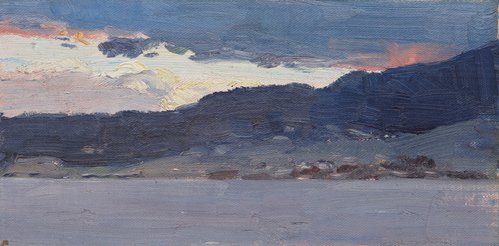-
Details
- Other Title
- One, not easily jealous but, being moved, perplexed in the extreme [Othello]
- Place where the work was made
-
Geelong
→
Victoria
→
Australia
- Date
- 1889
- Media category
- Painting
- Materials used
- oil on canvas on hardboard
- Dimensions
- 92.1 x 139.7 cm board; 101.5 x 152.1 x 3.2 cm frame
- Signature & date
Signed and dated l.l. corner, brown oil "T.R. [monogram] 1889".
- Credit
- Purchased 1960
- Location
- Not on display
- Accession number
- OA37.1960
- Copyright
- Artist information
-
 Tom Roberts
Tom Roberts
Works in the collection
- Share
-
-
About
'Jealousy' was one of the major studio paintings produced by Tom Roberts in the years following his return to Melbourne from his European sojourn in 1885. He first exhibited the work at Victorian Artists Society's exhibition in Melbourne in May 1889 with a title taken from a line from Othello: 'One not easily jealous, but being wrought, perplexed in the extreme'. Roberts clearly considered the work as one of his more ambitious to date, pricing it at £100 which was matched only by Arthur Streeton's 'Golden summers' and Frederick McCubbin's 'Down on his luck' in the exhibition.
At the time that Roberts exhibited 'Jealousy' he was painting works for the famous 9 x 5 exhibition, where his series of small landscape 'impressions' became characteristic of the plein air aesthetic which would earn him the title of 'Father of Australian landscape painting'. Roberts' influence in this regard is well documented, yet 'Jealousy' reinforces what was in fact his multi-faceted practice during this period, divided between (and mainly consisting of) studio as well as his more familiar outdoor painting.
'Jealousy' was something of a promotional painting of Roberts' studio skills, applying a set of thematic and compositional devices intended to appeal to Melbourne's middle class audience. He adopted what was a common compositional template - the interior scene depicting a human drama, with open door providing a glimpse of the world beyond. From this much-used structure, the distinction of Robert's work comes, in part, in his colour combinations. Avoiding the traditional brown tonality of works in this genre such as John Longtaff's 'Breaking the news' and Abbey Alston's 'Flood suffering', Roberts paints with sumptuous inflections of blues, reds and golds; revealing his knowledge of Whistler's 'Aesthetic palette'.
Roberts' drew on the popularity of theatrical expression of 1880s narrative painting in 'Jealousy'. He depicts a woman recoiling in horror as she listens to the flirting couple by the doorway. Using contrived emotional expression to enhance dramatic outcome, Roberts also implements the ambient light source from the doorway to (as Virginia Spate has noted) "give the drama the impact of reality".
In 'Jealousy' Roberts combined principles of Whistler's Aesthetic painting practice with the 'Aesthetic' markings of the 1880s fashionable interior. Roberts fills his work with the objects from his studio at Grosvenor chambers (acknowledged as one of the "best in Melbourne" for its décor). Oriental screens, fans, patterned wallpaper, and ceramics fill the interior in 'Jealousy' with an Antipodean offering of gum blossoms thrown into this Aesthetic mix. While Roberts paints the accoutrements of artistic fashion of 'Marvellous Melbourne', he too uses these as his compositional props to emphasise an off-centre spacing in the painting (a technique drawn from Whistler).
While 'Jealousy' did not initially sell at the 1889 VAS exhibition, it found a buyer the following year at the Gemmell, Tuckett and Co auction in Melbourne (where the work was presented under its current title - the one which it was commonly known by when the painting was in Roberts' studio). It was most likely to have been purchased here by Mrs Elizabeth Adeline Nasmyth of Geelong and the work remained in the family until it was offered to the Art Gallery of New South Wales for acquisition in 1960. While it was in poor condition (whose history of drying cracks are still evident on the painting's surface) Bernard Smith, Virginia Spate and Daniel Thomas who all viewed the work immediately recognised it as a major museum piece and has since remained known as one of Roberts' most important 1880s studio works.
Denise Mimmocchi
-
Places
Where the work was made
Geelong
-
Exhibition history
Shown in 5 exhibitions
Victorian Artists Society Winter Exhibition (1889), State Library of Victoria, Melbourne, 02 May 1889 -
Exhibition of Pictures by Fd. McCubbin, Arthur Streeton and Tom Roberts, Gemmell, Tucket & Company, Australia, 03 Dec 1890–05 Dec 1890
Purchases and Acquisitions for 1960, Art Gallery of New South Wales, Sydney, 22 Mar 1961–23 Apr 1961
Australian Impressionism, Ian Potter Centre: NGV Australia, Melbourne, 31 Mar 2007–08 Jul 2007
Open Studio (brick vase clay cup jug), Art Gallery of New South Wales, Sydney, 01 Jul 2023–07 Jan 2024
-
Bibliography
Referenced in 22 publications
-
Maurice Brodzky (Editor), Table talk, Melbourne, 18 Apr 1889.
-
Maurice Brodzky (Editor), Table talk, Melbourne, 26 Apr 1889.
-
Maurice Brodzky (Editor), Table talk, 'Art and artists. Victorian winter exhibition', pg. 6, Melbourne, 10 May 1889, 6. Review of the 1889 Victorian Artists' Society Winter exhibition.
-
Fred J. Broomfield, The Centennial magazine, 'Art and Artists in Victoria', pg. 883-889, Sydney, Jul 1889, 883 (illus.). Illustration is a reproduction.
-
Betty Currie, Girolamo Pieri Nerli (1863-1926), Melbourne, 1976, 16, (illus.). Illustration is pen outline of painting.
-
Gemmell, Tucket & Company, Exhibition of pictures by Fd. McCubbin, Arthur Streeton, and Tom Roberts, Tasmania, N.S.W., Victoria, at Gemmell, Tuckett & Co's rooms., Melbourne, Dec 1890. cat.no. 1
-
Janet Hawley, Good Weekend, 'Tom Roberts Bailed Up', pg. 32-39, Sydney, 24 Feb 1996, 35 (colour illus.).
-
Jeanette Hoorn, Reframing Darwin: evolution and the arts in Australia, 'Tom Roberts' portrait of Charlie Turner and Darwin's expression of the emotions in man and animals', pg. 118-135, Carlton, 2009, 131 (colour illus.).
-
Terence Lane, Australian Impressionism, 'Grosvenor Chambers, A phenomenon of Marvellous Melbourne', pg. 147-151, Melbourne, 2007, 327, 153 (colour illus.). cat.no. 8.4
-
John McDonald, Art of Australia. Vol 1: Exploration to Federation, 'The upward rush of youthful emotion', pg. 315-356, Sydney, 2008, 332 (colour illus.), 333.
-
Donald Richardson, Art & Design in Australia, South Yarra, 1995, 15, 60, 80, 83, 137, 140, 145, 163, 243. PS Worksheet 248
-
Virginia Spate, Tom Roberts, Melbourne, 1978, 56, 73, 75 (illus.), 76, 85, 87, 101, 148. illus.no. 21
-
Clare Temple, Foundation Newsletter #24, 'Curators' and coordinators' reports', pg. 8-11, Sydney, Jul 2014, 11.
-
Daniel Thomas, Art Gallery of New South Wales Quarterly, 'Tom Roberts', pg. 466-487, Sydney, Jul 1969, 468 (illus.).
-
Victorian Artists Society, Victorian Artists' Society catalogue of winter exhibition, May 1889, Melbourne, 1889, (illus.). titled 'One, not easily jealous but, being moved, perplexed in the extreme [Othello]'; cat.no. 38; priced £100; (illustration is a line engraving)
-
A.L. Windsor (Editor), Age, Melbourne, 04 Dec 1890, 2, 5.
-
A.L. Windsor (Editor), Age, Melbourne, 04 May 1889, 10.
-
Editor Unknown (Editor), Argus, Melbourne, 04 May 1889, 12.
-
Editor Unknown (Editor), Argus, 'Saturday afternoons: at the opening of the Artists' exhibition', pg. 7, Melbourne, 06 May 1889, 7. Review of the 1889 Victorian Artists' Society Winter exhibition.
-
Illustrated Australian news and musical times, 'The Victorian Artists' Society', pg. 21, Melbourne, 01 Jun 1889, 21. Review of the 1889 Victorian Artists' Society Winter exhibition.
-
Editor Unknown (Editor), Argus, Melbourne, 04 Dec 1890, 7.
-
The Australasian, 'The pictorial: pictures at the Victorian Artists' exhibition', pg. 968, Melbourne, 11 May 1889, 968. Review of the 1889 Victorian Artists' Society Winter exhibition. Pages in 'The Australasian' were numbered from the first issue of the year.
-




